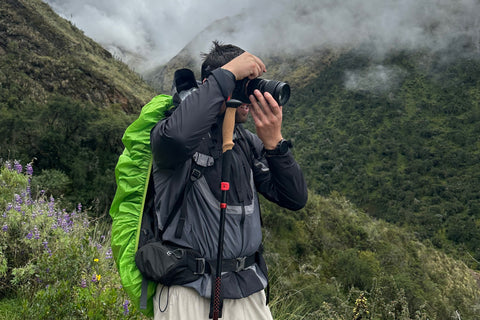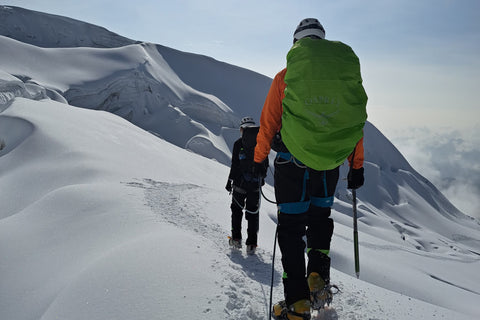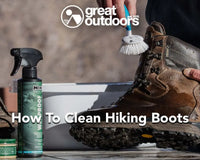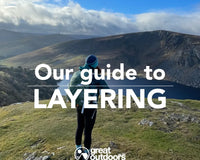The Benefits of using Walking Poles

Walking poles, also known as trekking poles or hiking sticks, offer several benefits that can enhance your walking or hiking experience. They tend to split opinions within the hiking community and in our customers minds! Here's why you might consider using them:
Benefits of Using Walking Poles
-
Increased Stability and Balance: Poles provide more points of contact with the surface below you - which creates a better balancing platform for you.
-
Reduced Impact on Joints: By using walking poles, you can distribute some of your body weight onto the poles.This reduces impact on your knees and ankles over time - especially for when you walk downhill.
-
Improved Endurance: Poles can help you maintain a consistent rhythm and pace. They can also help you to propel yourself up a hill with ease.
-
Engaging Upper Body Muscles: Using poles involves your arms and shoulders, turning your hike into a full-body workout which keeps you nice and warm!
-
Aid in Crossing Obstacles: Poles can be useful for crossing streams, navigating muddy paths, or moving aside small branches, making your hike safer and more manageable.

How long should my walking poles be?
We feel that as a rule of thumb to keep in mind - your walking poles should be long enough to keep your elbow at a 90-degree angle from your body as shown in the image below!
What height walking or trekking pole should I buy?
We feel that for walking poles - you should generally use the following size chart we have made to show which length walking pole may be suited best to your height. If you want to see a more in-depth video to see what model may suit you - check out this video from REI.
|
Height |
Suggested Approx. Pole Length |
|
< 5 ft. 1 in. |
100-120 cm (39 in.) |
|
5 ft. 1 in. - 5 ft. 7 in. |
110-125 cm (43 in.) |
|
5 ft. 8 in. - 5 ft. 11 in. |
120-130 cm (47 in.) |
|
6 ft.+ |
130-140 cm (51 in.) |
Check out our range of Walking/Trekking Poles
Why use wrist straps on walking poles?
Wrist straps are a beneficial feature of walking poles, enabling you to maintain a relaxed grip. To effectively use the straps, insert your hand upwards through the strap, creating a large "O" with your thumb and forefinger before wrapping it around the pole's handle. This technique allows you to exert downward pressure not through a tight grasp, but through the tension between your wrist and the strap. Consequently, as you walk, the poles naturally extend the fluid movement of your wrists, arms, and overall body, enhancing the walking experience.

What features to look out for in Walking Poles?
Trekking poles have several features and materials - here are some things we think are worth keeping an eye out for when you are buying a new pole or set of poles.
Trekking Pole Locking Mechanisms
All trekking poles feature locking mechanisms to prevent them from adjusting in length unexpectedly during use. For poles that are not adjustable, these mechanisms allow the poles to be extended to their full length for use and collapsed for storage. Adjustable poles operate similarly, but their locking mechanisms also enable the adjustment of the pole's length across two or three interlocking sections, typically ranging from 24 to 55 inches. This feature allows you to customize the poles according to your height and the terrain you are navigating. Explore a range of adjustable trekking poles with various locking mechanisms on our Trekking Pole Collection.
The most common types of locking mechanisms include:
-
External Lever Lock: Features a lever-based, clamp-like mechanism that facilitates quick and easy adjustment of pole length, even when wearing gloves.
-
Push-Button Lock: These poles snap into place and lock with a single pull. A push-button releases the lock, allowing the poles to collapse. Some models do not offer length adjustment.
-
Twist Lock: Utilizes an expander and screw setup, known for its strength and durability.
-
Combination Lock: Combines different locking mechanisms to achieve optimal strength, light weight, and ease of use. For instance, a pole might incorporate an external lever lock on the upper section and a twist lock on the lower section.
It's important to regularly check that all locking mechanisms are securely fastened before hiking, especially with lever locks, where the clamping tension might need adjustment.
Trekking Pole Shaft Materials
The composition of a trekking pole’s shaft significantly influences its overall weight and durability:
-
Aluminum: Known for its durability and cost-effectiveness, aluminum poles typically weigh between 18 and 22 ounces per pair. The weight and price may vary slightly depending on the gauge of the aluminum, which ranges from 12 to 16 mm. While aluminum can bend under extreme stress, it is less likely to break.
-
Composite: These poles feature shafts made entirely or partially from carbon. As a lighter but more expensive option, they average between 12 and 18 ounces per pair. While effective at reducing vibration, carbon-fiber poles are more susceptible to breaking or splintering under high stress, making them less ideal for rugged or remote hiking areas.
Trekking Pole Grips
Trekking poles may include ergonomic grips with a 15° corrective angle to maintain a neutral and comfortable wrist position. Additionally, some hiking staffs are equipped with grips similar to those found on walking canes, offering substantial support for casual walking and light hiking.
Grip Materials
The material of the grip affects the tactile experience during hikes:
-
Cork: Best for hot climates as it resists moisture from sweaty hands, minimizes vibration, and molds well to the hand’s shape.
-
Foam: Absorbs moisture and is the softest option, ideal for those who prioritize comfort.
-
Rubber: Provides insulation from cold, shock, and vibration, making it suitable for cold-weather activities. However, it can cause chafing or blisters in warm weather due to its tendency to irritate sweaty hands.
For a more detailed exploration and to find the perfect trekking pole for your needs, check out our range of Walking/Trekking Poles.
Where can I buy Walking Poles for hiking?
You can find walking poles, trekking sticks, walking pole tips and much more online or in-store at Great Outdoors
We have the experience and expertise to help you find the right size and model for your adventures. Need to know more about it or want to know our options? Click here to Contact us!







